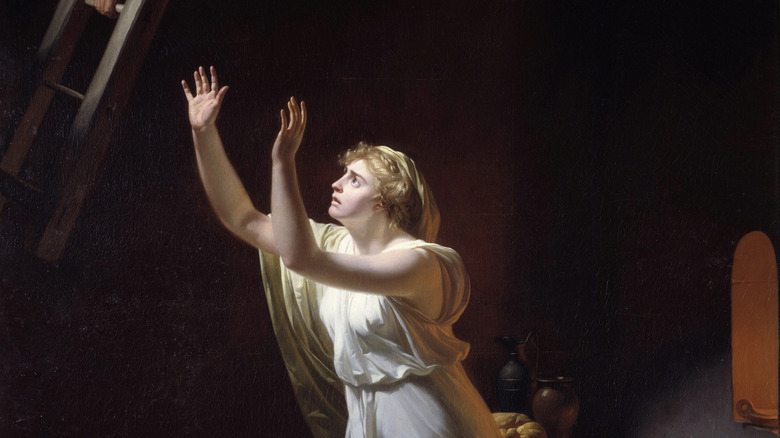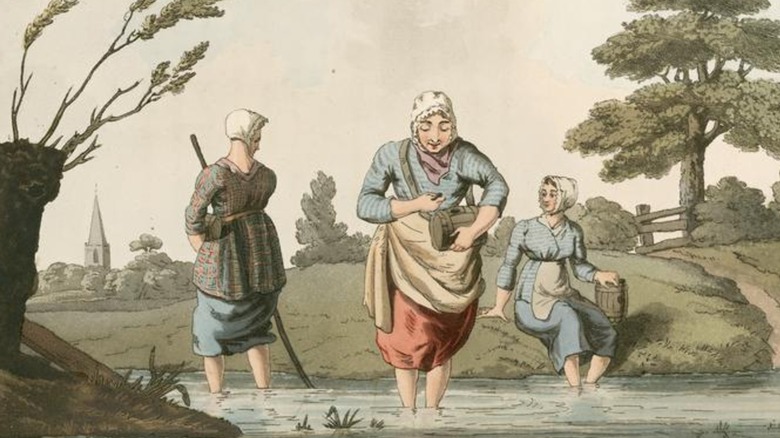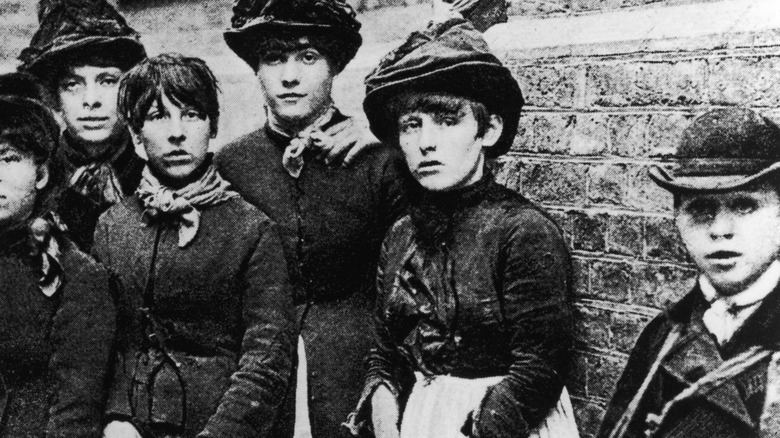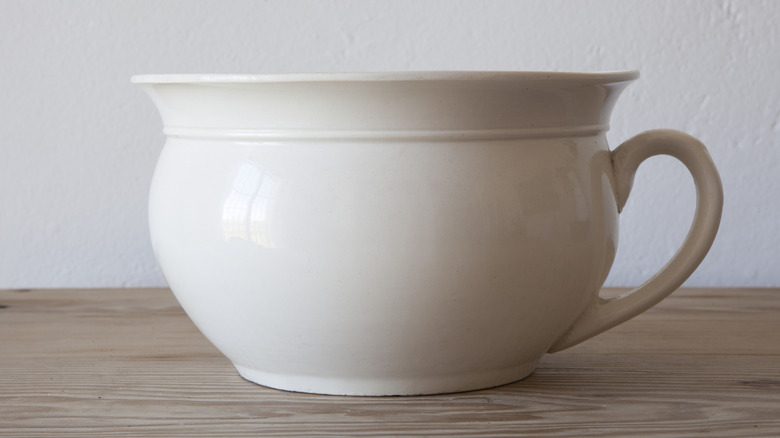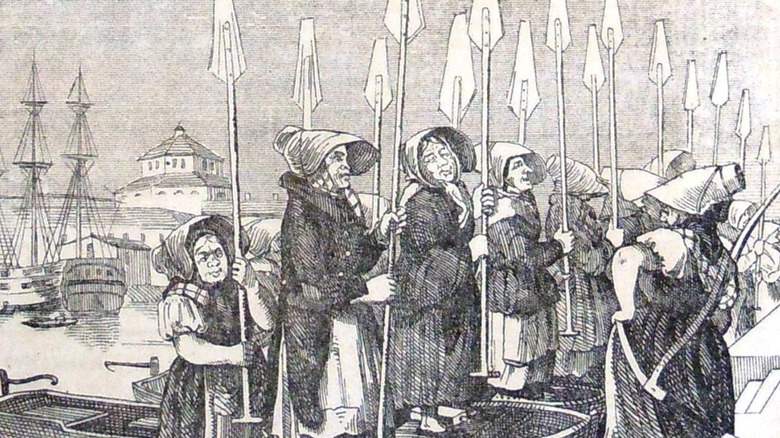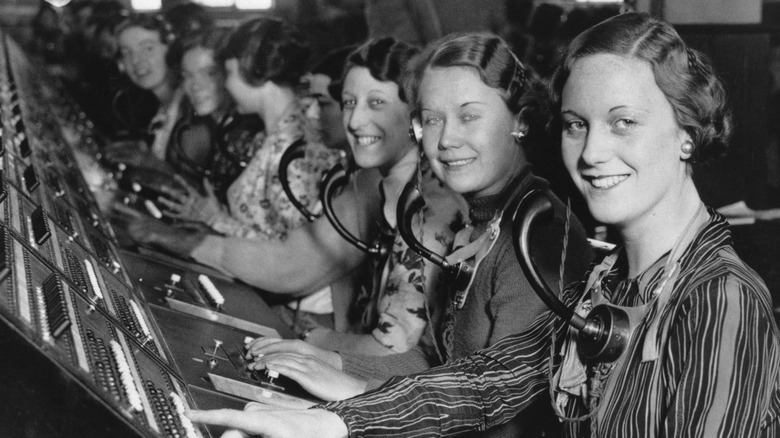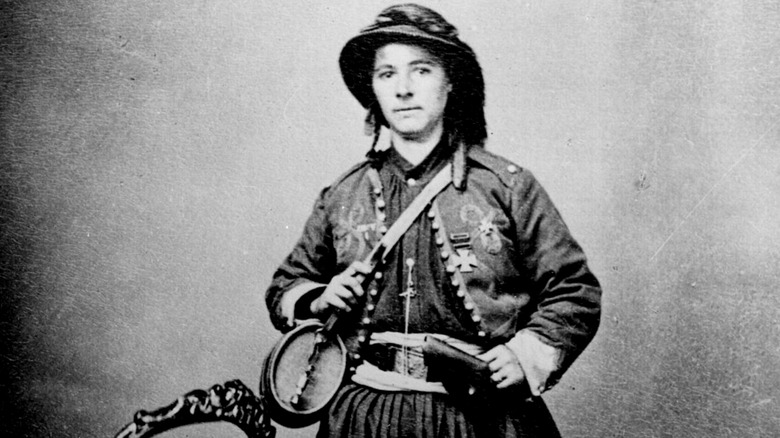The 11 Strangest Jobs Done By Women That No Longer Exist
The obstacle that prevented white-collar women from achieving the same professional heights as men was given a name in 1979, when Pingv co-founder Katherine Lawrence reportedly coined the term "glass ceiling." While the World Economic Forum says nations are more than 120 years away from achieving gender parity, there are a few sectors dominated by women — albeit mostly at the lower end of the pay scale. In the United States, the vast majority of early childhood teachers are women, and they make up almost 80% of healthcare staff, though men are more likely to be the active physicians.
There are a few niche areas where women take the lead over their male counterparts. In South Korea, free divers called "haenyeo" earn a living harvesting abalone (while also raising their children), enabling the men to do the treacherous work of boat fishing. A similar job exists in Japan, where divers, many of them middle-aged women, are known as "ama," and their tradition is passed down the maternal line.
In many countries, women can be professional mourners at a funeral, though in Romania, they attract the misgivings of the Church, while in Greece, moirology traces its roots to classical times. In the 21st century, more men have started to join the industry, proving gender parity works both ways. Some female-only roles, however, have not stood the test of time. Check out these strange jobs for women that would never fly today.
Radium dial painter
In this digital age, millions rush to get their hands on the latest tech innovation. In the 1910s, the trend was products that glowed in the dark, thanks to the discovery of radium in 1898. It was the hottest of products, widely believed to have invigorating health properties and extremely useful for painting the faces of timepieces.
In the United States, several companies opened factories that employed mainly women for the painstaking work of dusting dials with luminescent powder and coating the numbers and hands with radium-laced paint. The latter job, in particular, included a specific requirement: The tip of the paintbrush had to be made into a point, and the women were encouraged to use their mouths to achieve this. Many were happy to do so, thinking the radium was harmless and even painting their teeth with it for the brightening effect.
Unfortunately, the messed up truth about the Radium Girls, as they came to be known, was that the tiny amounts of paint they swallowed had catastrophic effects on their bodies. Many developed horrendous, debilitating illnesses, and some even died. The United States Radium Corporation and the Raydium Dial Company insisted radium was not deadly and claimed they were not responsible for the girls' poor health — all the while the lawsuits mounted. While some workers received a few thousand dollars in compensation, most didn't. Some good did come out of the horrendous situation: These women's tragic experiences set a benchmark for British workers' safety.
Human computer
In 2025, Meta CEO Mark Zuckerberg made headlines by suggesting on "The Joe Rogan Experience" that corporate America was "neutered" by inclusive policies while also advocating for women's success. His comment is a reflection of the 21st-century tech industry in the United States, which is dominated by white men. But that wasn't always the case. For almost 100 years — from around 1890 to the 1980s — women, including Black and Indigenous women, were very much the nascent tech sector's driving force.
It began in the late 19th century with Williamina Fleming, housemaid to the Harvard Observatory's Edward Pickering, who, alongside 14 other women, proved to be more reliable — and cheaper — than men. In the 1930s, the Works Progress Administration, a government agency, hired women to carry out complex calculations that men viewed as repetitive and dull. During the Second World War, the hiring boom continued for women, including for the Manhattan Project and NASA's Apollo space missions.
Despite their stamina, mathematical abilities, and programming skills, female "human computers" faced twin threats: The digital systems they helped develop and the increasing appeal of their work to men. Throughout the 1970s and 1980s, swathes of women were pushed out of or left the industry, while the home computer boom targeted a new generation of tech innovators: boys. Currently, the likelihood of another female-dominated section of Silicon Valley is remote. By 2024, only 33% of digital sector staff in the U.S. were women, and half of them leave before they hit their mid-30s.
Herb strewer
Being royal comes with all sorts of strange rituals and traditions. Keeping a monarch happy has historically been a full-time job, calling on all kinds of people to carry out numerous tasks, often invisibly. One of the few positions done in public exclusively by women was that of an herb strewer, which dates back to the 1625 coronation of King Charles I. As the job title suggests, it required herbs and flowers, including pennyroyal and lavender, to be scattered about places the king would frequent, both indoors and outside.
The sweet-smelling greenery would help mask the foul smells coming from the Thames, which was historically used as a dump for sewage before toilets came along. The first woman to occupy the role was Bridget Rumney, who earned a princely £24 per year (equating to over £4,000, or around $5,200 as of this writing). Mary Rayner was the last-known full-time herb strewer, employed in the 18th century.
In 1821, Anne Fellowes (sometimes written Fellows) was appointed as herb strewer for George IV's coronation, where she and six "herbswomen" would scatter flowers from the start of the royal procession to Westminster Abbey. They were the only women to attend the event. Queen Victoria ultimately put an end to the herb strewer's work, though Jessica Fellowes, niece of "Downton Abbey" writer Julian, applied for the job for King Charles III's coronation. It was politely declined.
Leech finder
Throughout history, women who practiced medicine have been erased from or ignored by the records or vilified as witches by a paranoid or suspicious society. But there were a few instances where women could legitimately contribute to the medical field, and being a leech finder was one of the weirder roles. Although some men did this stomach-churning job, it was women looking to earn a little money who provided much of the workforce.
They were depicted by artist George Walker in his 1814 painting in Yorkshire of Scottish women, their skirts lifted to their knees, standing in water. The image is calm and placid, but the reality was quite different. They would walk in freezing bogs or marshes, their legs exposed to attract the bloodsuckers — a method that was cheaper than using an old horse's leg. The creatures had to remain attached for several minutes so they were easier to remove, but not every wound would instantly close. Apart from blood loss, women also risked falling ill from diseases transmitted by the leech.
Traditionally, the work was seasonal, but during the 19th-century frenzy, thousands of the creatures were needed, putting the medicinal leech in danger of being wiped out — and hundreds of women's livelihoods on the line. Ironically, the shift away from bloodletting amid a greater understanding of germs did what mass consumption couldn't: The job of leech finder was consigned to history, while medicinal leeches are now raised in specialist laboratories and the London Zoo.
Match woman
Our 24/7 world is illuminated by electricity, some of it generated by the sun. While the unfortunate truth about solar panels is that they aren't ethically all that, they are light years away from candles and an industry that employed hundreds of women who sparked a protest that would make history. Friction matches were discovered by accident in 1827, and by 1861, William Bryant and Francis May opened a factory in East London, where business boomed.
Many of their employees were women, often Irish immigrants, who worked long hours in awful conditions, and whose already low wages could be docked for the slightest reason. As if all that wasn't appalling enough, workers also used white phosphorus, a dangerous chemical that led to a disease called "phossy jaw" and had been banned in some countries — but not the United Kingdom. The more successful the match companies became, the more their women workers suffered. Their pay was cut, and if they got sick or died, they could be quickly replaced.
In 1888, Annie Besant published "White Slavery in London," blowing the whistle on the horrendous conditions (via Mernick). Bryant and May tried to persuade staff to denounce the article by firing one woman, little realizing her co-workers would go on strike and achieve the unthinkable: Rally public and political support. Within a month all the women's demands were met, including the right to form their own union, laying the foundation for future U.K. labor laws that would prevent a repeat of such deadly working conditions.
Necessary women
In the 15th century, one of the most powerful jobs at King Henry VI's court was yeoman or groom of the stool. He took care of the monarch's toilet activity, cleaning up the king's body and getting rid of his "business." Under Tudor queens Mary and Elizabeth, that job naturally went to a woman, who was dubbed "lady of the bedchamber."
Both positions offered unrivalled, intimate access to the royal ruler, and certainly in the groom's case, it came with a lot of perks, including somewhere to live and cast-off clothes from the king. Although Edward VII abolished the role when he ascended the throne in 1901, it didn't prevent the wealthier classes from needing someone to clean out their chamber pots. That duty predominantly fell on women. While ordinary folks emptied their pots out into the street for night soil men to collect, rich people had housemaids to whisk them out of sight.
In the 17th century, we see the first mention of the "Necessary Woman to the House of Lords," a post of servant women would have to clean and replace the chamber pots several times a day to ensure all the guests' toilet needs were met — ick. Although being a necessary woman was essentially the same messy job as the lady of the bedchamber, being a necessary woman lacked its royal predecessor's prestige. The position was abolished in 1850, and relief came with the advent of more hygienic flushing toilets, though it took until 1905 for London's women to get their own public convenience.
Ornatrix slave
Women make up 90% of workers in today's hair and beauty industry (yet still earn on average less than their male counterparts), but it's a sector that has always had a strong female presence. In Roman times, when a woman's appearance — particularly her hair — was seen as a status symbol, specialist slaves called ornatrices would take care of their mistress's coiffure.
Unlike modern hairdressers, there was no friendly chit-chat while sitting under the dryer. The ornatrix, like all other household slaves, was at the mercy of her owner's whims, whether that was pulling out gray hairs or piling her hair fashionably high, with punishments including whipping — something that would never happen in your average salon today. Although there are lots of modern treatments to treat hair these days, a Roman ornatrix had to make do with rotting leeches, pigeon droppings, or urine to achieve the required look.
They also handled lead-coated combs and mixed earthworms with ash and crushed walnut shells to disguise gray hair (though having blonde hair was associated with prostitution). Their beautifying work also extended to dressing their mistresses, whitening their skin, and applying face makeup that included soot and rust. One false move and the ornatrix could be beaten, or worse. The constant threat of violence prompted Roman poet Ovid to warn Roman women not to treat their slaves badly, and if they were having a bad hair day, to post a guard at their door to prevent people from seeing them.
Rowing madam
Seventeenth-century Stockholm was tricky to walk around, thanks to its cobbled streets, so people took to the city's many waterways, riding in boats helmed by "roddarmadammer," or rower women. Far from being the weaker sex, these women were rough, ready, and had plenty to say for themselves. But they were also hard workers: Many of them were the only ones bringing money in for their families. A team of up to three women operated each longboat, which had to be "numbered, commodious, good, and strong, and constantly kept tidy," via New Sweden.
The women too were also expected to behave in an orderly and "sober" way, both with passengers and among themselves, according to a code that was issued in 1759 but rarely enforced. For almost 200 years, these rowing madams dominated the Stockholm waters, but trouble brewed in 1844. The women got wind of plans by some of the Royal Navy's carpenters to launch a rival service, and they swiftly called on the Chamber of Commerce to prevent their business from being impacted.
In a deferential letter that played on their roles as women and sole breadwinners, they begged the Chamber to reject the carpenters' application and support their trade. It worked, and by the 1870s, around 200 women operated boats. The rise of steam power saw their numbers inevitably decline, but rower women remain an important part of Stockholm's history. Will people say the same about women Uber drivers in 100 years' time?
Vestal Virgin
Imagine: You're the daughter of a prominent family, aged between 6 and 10, but instead of entering first grade, you ritually join a goddess-worshipping cult for the next 30 years. Weird? Yes, but that's precisely how Vestal Virgins were selected in ancient Rome. These half-dozen women (and girls) enjoyed an incredibly high status in return for their three decades of service to the centuries-old Vesta cult.
Although they had to remain chaste (it was part of the job description, after all), Vestal Virgins were allowed to vote, own property, and could even free enslaved people. Should a condemned prisoner catch the slightest glimpse of a Vestal, they would be freed. After 30 years, a Vestal would be released from her vows and could marry, living a "normal" life, if she chose. Unsurprisingly, many of them decided to stay with the order.
But these extraordinary women didn't have things all their own way. If a Vestal failed in her duties, which included ensuring the sacred flame of Rome did not go out, she could be beaten, but the worst punishment was reserved for those who broke the vow of chastity. It was forbidden to touch or kill a Vestal virgin, nor could anyone be buried within the Eternal City's walls, so ruler Tarquinius Priscus got around both problems with a terrible decree: A guilty Vestal would be given enough food and drink for a few days before being locked in a room and left to die.
Switchboard operator
It's hard to imagine how we managed without cellphones, let alone a time when we needed a middleman — or more accurately woman — to make a call. Yet at the start of the 1900s, as the United States' phone network was being built, that's how things worked. Strangely, teenage boys were the first switchboard operators, but complaints forced companies to seek replacements, and they found them in young women.
Being a "telephone girl" was a welcome alternative to working in a factory or as a household servant, though, like many other jobs women did, salaries were a fraction of what men earned. There were also very strict rules to becoming a switchboard operator. Women were often young, unmarried, educated, from a respectable family, and in good health. Elocution lessons were routine, while women with foreign accents were not employed.
Women who fitted the bill could expect to work for up to 12 hours, crammed in front of a switchboard (less-than-slender operatives need not apply) while wearing very heavy headsets. As for the number of calls they handled? Around 250 to 350 per hour at larger companies, or around one every 10 to 15 seconds. By 1946, around 250,000 female switchboard operators were fundamental to the success of the telecommunications industry. They knew it too and lobbied for a slew of women's workplace rights, including a month's paid maternity leave, before technology moved on and switchboards became obsolete.
Vivandiére
Wars have been going on for thousands of years, and not all of them were fought exclusively by men. Many women's roles in combat are all but forgotten, but other female figures of the battlefield have also been sidelined: The vivandiéres. Also known as cantinières, they originated in 18th-century France and kept the fighting soldiers supplied with food, wine, and tobacco, alongside other necessities ranging from writing paper to wig powder. Think of them as the in-person online marketplace of their day.
They became synonymous with the tonnelet, a small barrel of brandy they carried over their shoulder, and, unlike other camp followers or hangers-on, vivandiéres wore a military-style uniform that included a short skirt that overlaid trousers. In France, these women were considered a crucial part of the regiments they supported, reducing desertion and, in some cases, taking up arms alongside the men.
That was also the case in the United States during the Civil War's earliest years and on both sides of the conflict. Vivandiéres — dubbed "daughters of the regiment" — such as Marie Tepe, also known as "French Mary," fought at Fredericksburg and Gettysburg and, like other women, provided medical care to men, even as fighting raged around them. Despite their obvious courage and willingness to take up arms, Union General Ulysses S. Grant ordered all women to leave the battlefields in 1864, but their French counterparts were still in action up to the First World War.
